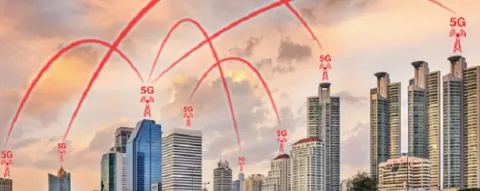
The debut of the fifth generation wireless system -5G- is imminent. A formalised standard should be in place by 2018 ahead of early rollouts in 2020 and its effects are believed to be revolutionary, both for mobile users and the cities they’re living in.
We have picked a few areas to showcase what is possible when municipalities welcome next-generation wireless technology. These examples also illustrate how wireless connectivity will create jobs, generate municipal efficiencies, and increase government revenues.
Technology research firm Gartner said that in 2017, an estimated 380 million “connected things” will be used by cities to help deliver sustainability and climate change goals.In 2020, this number is predicted to increase to 1.39 billion units solely due to smart cities’ usage of 5G for 20 percent of its “connected things.”
The key attributes of 5G that will benefit Smart Cities include higher network speed and more connections, enabling wireless connectivity in unprecedented locations; quicker and more adaptive response times to support time-sensitive applications, such as vehicle-to-vehicle communications; and ultra-low-power connections, such as sensors for leak detection in water mains.
Benefits of 5G
Transportation: Connected cars are one way forward, while self-driving systems and enhanced GPS capabilities are another. Driverless cars will be able to connect with one another, read live traffic reports and even communicate with street lighting, leading to more efficient energy usage, safer streets and less congestion.
Energy and Utilities: 5G will help cut costs and secure facilities, with Smart Grid benefits estimated to be as high as $2 trillion over the next 20 years. Benefits for businesses include quicker introductions of new products and services to consumers, in addition to remote monitoring and maintenance in potentially hazardous locations.
Healthcare: Medical care could reach rural communities at a quicker and more substantial rate, significantly boosting the current telemedicine practices in place.
5G in Motion
Electric companies and cities are already incorporating smart city initiatives using current technology with machine-to-machine communication. One simple example is how parking systems are communicating with a city’s car parks to display the number of free spaces available. In the US and Ireland, companies like the Tennessee Valley Authority and EirGrid are making use of a distribution technology that can properly detect and allocate the necessary amount of fossil fuel-generated power when and where it’s needed.
Global telecommunications equipment company, Qualcomm plans to conduct 5G New Radio (NR) field trials with two tier-1 operators and will partner with Vodafone group in the UK to test 5G interoperability and conduct an over-the-air field trial based on NR specifications.
The Future of 5G
For a glimpse at what an entire smart city may look like a decade from now, Yinchuan, in northwest China, is the perfect example, incorporating 13 Smart City initiatives. The city significantly increased its data handling capacity by constructing an 8000GB fiber optic network and the installation of over 5000 WiFi access points across the city with the help of global telecommunications company ZTE.
With this as an example, there are a number of steps that a municipal leadership can take to advance the rollout process of 5G in their city, such as streamlined approval processes, providing access to government-owned sites or assets for small-cell infrastructure, and simplifying fee structures.



